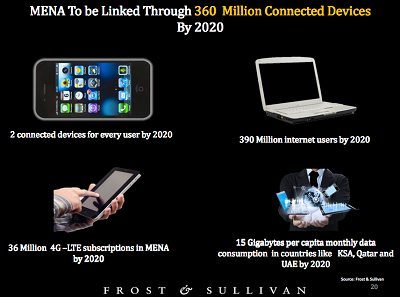There will be four billion connected devices by 2020 across the Middle East and North Africa (MENA) region,  according to a new forecast by Frost & Sullivan, a research company based in the United States.
according to a new forecast by Frost & Sullivan, a research company based in the United States.
Such items include gadgets and home appliances with access to the internet and the ability to communicate with one another.
While part of the forecast is based on population growth, the technological key is 4G – mobile network technology with three times the speed and capacity of its predecessor, 3G. That greater capacity means it can move much more data without glitches arising.
How might daily life be different if Mobile2Mobile caught on?
Once you leave work and head towards the car park, your car senses your presence (through your smartphone perhaps) and switches on the engine. When you arrive at your villa, the garage doors (it’s a pretty nice villa) open automatically without the need to press any buttons. The lights in your living room switch on as soon as you step through the front door and the television switches on with your favorite channel.
Key takeouts from the research are:
- The Middle East and North Africa (MENA) is expected to be linked through 4 Billion Connected Devices By 2020, which means six to seven connected devices per household by 2020.
- MENA companies are warming up to the transformative impact and benefits of Big Data Analytics technology on sectors such as Healthcare, IT, Logistics, Media and Entertainment, and Banking and Financial Service.
- Connected living is anticipated to become a reality in MENA, with Connected Home (Devices such as Internet Washing Machine, Internet refrigerators, and Internet Air Condition Control), Connected Vehicles (Connected Cars: Extension of connected life, remote maintenance monitoring), and Connected City (eGovernance, WiFi Malls).
- The entire gamut of connected living and smart city applications is expected to create huge business opportunities with a global market value of $1.5 Trillion in 2020.
- Global online retail sales to account for 16.6% of total retail sales by 2020, indicating that one out of every 10 retail transactions will be an online transaction. This increase in online retailing is ushering new urban logistics business models. MENA retailers will branch out into multi-channel models to enhance customer experience.
- Smart Cities making huge headway into MENA. King Abdulla Economic City is soon to be one of the top Smart Cities in the region.
- MENA’s GenY will continue to account for over one-third of the region’s population by 2025.
- The compound impact of Mega Trends will bring in a paradigm shift towards social trends such as “She-conomy” (Women’s increasing participation in education and employment to boost economy), surge in Asian work pool, generational political shift, reverse brain drain, and Halal economy.
- Robots will revolutionise classrooms, personal and public services in MENA.
- Economic Trends such as diversification will prevail with the MENA region realigning its economic balance to migrate from being an oil-dependent economy to a more sustainable model that encourages inclusive growth. The contribution from oil exports to the GDP for most major oil exporters of MENA is expected to decline significantly by 2020.
- The UAE is expected to be the top contributor to the MENA GDP by 2020.
- Cities, and not countries, will drive wealth creation in the future. Cities like Cairo will account for more than 77% of the country’s GDP by 2020; Abu Dhabi around 48% (2020); and Dubai and Tehran around 26% (2020).
- Demand for healthcare in the Gulf Cooperation Council (GCC) is expected to demonstrate double digit growth driven by rapidly growing population, rising income levels, increased insurance penetration, and an increased prevalence of lifestyle-related diseases.
